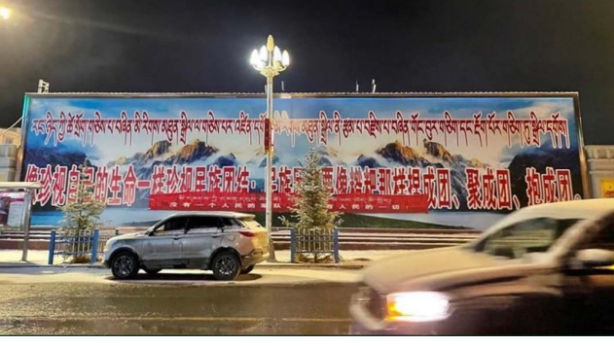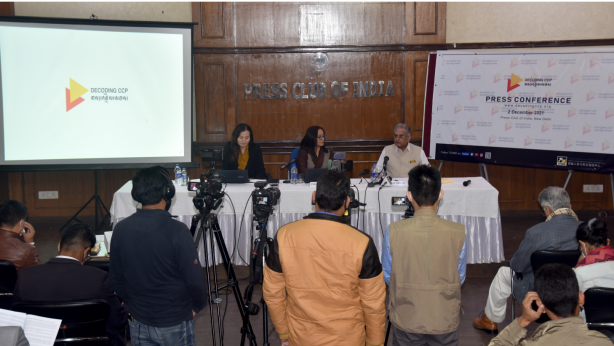TCHRD releases Annual Report 2000: Tightening the Control
The Tibetan Centre for Human Rights and Democracy (TCHRD) today released its annual report entitled “Tibet: Tightening of Control” on the human rights situation in Tibet for the year 1999. The 140-page report documents the continuing systematic denial and violations of the freedom of religion and expression; the exercise of arbitrary detention and torture; the violation of the right to be free from racial discrimination; the abuse of women and children’s rights in Tibet throughout the year 1999. The report highlights the repeated failure of the People’s Republic of China (PRC) to promote and protect the fundamental human rights and freedoms of the Tibetan people.
The past year was marked by the official celebration of several politically significant anniversaries, including fifty years of the founding of the PRC and forty years of the annexation of Tibet. The symbolic importance of these events was characterised by various attempts by the Chinese government to display its authority and legitimacy, resulting in further violation of the human rights of the Tibetan people. Within China and in Tibet there was a tightening of the state’s control over every sphere to consolidate its power. Throughout the year, Chinese authorities tightened its security and surveillance in all major cities and towns to prevent incidents of nationalist dissent. Any attempt at questioning the legitimacy of the state was ruthlessly crushed. And yet as the state tightened its iron grip, there were various reports of Tibetans resisting against the repressive policies of the Chinese government.
China’s most gruesome repression against Tibetan people reported last year was the opening fire at over 3,000 Tibetans who were holding a peaceful demonstration calling for the release of a renowned religious teacher. At least 80 Tibetans were arrested following the demonstration. “This demonstrates China’s total failure to tolerate and respect the Tibetan people’s right to freedom of expression,” commented Lobsang Nyandak, Executive Director of TCHRD.
As of December 1999, TCHRD has documented 615 known political prisoners currently imprisoned in various Chinese prisons in Tibet, including 162 women. Of these 62 are serving sentences of ten years or more.
China continued to use charges of ‘endangering state security’ to suppress freedom of expression in Tibet. 130 Tibetans were arrested last year for exercising this right.
Eight political prisoners have had their prison sentences prolonged following the peaceful protests in Drapchi Prison in October 1998. Ngawang Sangdrol, the longest serving female political prisoner, is now serving a total sentence of 21 years after her sentence was extended for the third time by four years. Ten deaths were reported as a result of shooting and torture following the protests.
“There are many political prisoners who are in critical health conditions and need urgent medical care. Chinese authorities have consistently ignored repeated appeals to release them on medical parole and to provide them with immediate treatment,” said Mr. Nyandak.
The report also documents widespread religious persecution in Tibet. Last year, 1,432 monks and nuns were expelled from their religious institutions for defying Chinese ‘work team’ orders to denounce the Dalai Lama and oppose those who advocate independence of Tibet. Those expelled include 244 monks and nuns below the age of 18. ‘Re-education’ programmes continued in various religious institutions, infringing upon the religious freedoms of the Tibetan people. Under the pretext of supervision, restrictions are placed on the age of the monks and nuns in an attempt to reduce the monastic population.
Since the commencement of the ‘Strike Hard’ campaign in 1996, TCHRD has recorded 11,409 expulsions, and 541 arrests of monks and nuns.
The prevalence of torture as a means of crushing the resistance of individuals is alarming. There have been reports of the use of torture in almost every institution of the state: starting from incarceration, during initial detention and interrogation, and in prisons. Last year TCHRD has reported ten torture-related deaths, six of them occurred in 1999. Since the PRC signed the Convention Against Torture, 69 Tibetans have died as a direct result of torture by officials of the Chinese government.
The rights of Tibetan women and children continue to be violated at a large scale in Tibet. China has ratified both the conventions protecting the rights of women and children. Yet, reports in 1999 indicate that China fail to uphold the provisions of these Conventions. There have been reports of Tibetan women subjected to forced abortions, contraception and sterilisation by the Chinese authorities. ‘Unauthorised’ pregnancies have resulted in fines, intimidation and denial of privileges, including the right to education for children. There are confirmed cases of Tibetan women dying from forced sterilisation. China continues to detain the ten year-old Gedhun Chokyi Nyima, the XI Panchen Lama of Tibet, along with his family. His current condition and whereabouts are unknown. Chinese authorities have consistently refused requests by concerned governments and organisations seeking access to the child.
“The Chinese government claims that there has been ‘earth-shaking’ progress in social developments and in the human rights situation in Tibet in the last four decades under the Communist rule. However they refuse to acknowledge the fact that thousands of Tibetans continue to flee Tibet every year to escape China’s oppressive policies. Last year 2,474 Tibetans fled Tibet, including 1,115 children below the age of 18,” reported Nyandak.
The transfer of Chinese into Tibet is the most serious threat to the survival of the Tibetan people and culture. Population statistics estimate more Chinese than Tibetans in Tibet, thereby marginalizing Tibetans in all sectors of the economy. In 1999, for the first time ever, an international organisation was involved in a plan that would further China’s policy of population transfer. The World Bank partially funds the Western China Poverty Reduction Plan. If implemented this project will reduce the percentage of Tibetans in Dulan County from 22 to 14 per cent of the total population.
Despite claims made by the Chinese authorities of economic development and growth in Tibet, the reports received last year indicate that these ‘developments’ have benefited mainly the Chinese settlers. Repressive and arbitrary rural taxation measures are further exacerbating the conditions of poverty for Tibetan nomads and farmers. Most of the basic rights associated with a ‘welfare state’ like the right to housing and health remain unfulfilled.
Despite being a State Party to the International Convention on the Elimination of All Forms of Racial Discrimination, Tibetans continue to be discriminated against by the Chinese authorities. Tibetan refugees continue to report unfair and unequal treatment in the fields of public representation, education, employment, housing and health services.
“International governments, lured by China’s economic prospects, continue to capitulate to the Beijing government. The European Union decided not to co-sponsor a US human rights resolution during the 55 UN Commission on Human Rights, assuring its defeat. The governments need to review their position on human rights issues and embark on the new millenium with a note of hope and justice for the oppressed people in the world,” added Mr. Nyandak.


